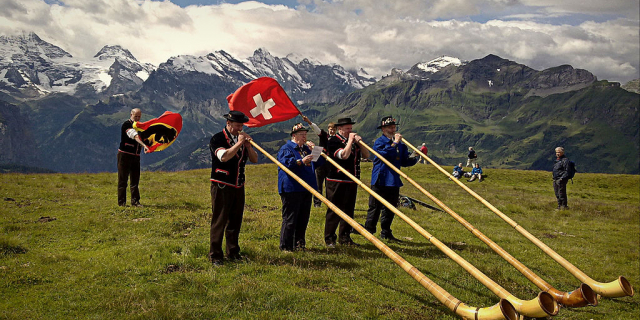Aigle (French for "eagle", pronounced [ɛɡl]; Arpitan: Âgllo) is a historic town and a municipality and the capital of the district of Aigle in the canton of Vaud in Switzerland.
The official language of Aigle is Swiss French.
 Centre
Centre Hotel Aigle between 1890 and 1900
Hotel Aigle between 1890 and 1900The municipality was settled very early. Burials and ceramics from the Bronze Age have been discovered. During Roman times, Aigle lay on the road from the Great Saint Bernard pass via Viviscus (Vevey) to Aventicum (Avenches), the Roman capital. The Romans had a number of names for Aigle: Ala (Wing), Alena (Little Wing), Aquilegia and Aquilas (Eagles).
The first medieval mention of the municipality occurs in 1150 under the name of Alium.[1]
A mention in 1153 gives the name as Aleo.[1] Holy Roman Emperor Henry IV gave the territory of Aigle in 1076 to the house of Savoy. The Abbeys of Great Saint Bernard and Saint-Maurice also had holdings in Aigle, and the latter established a priory, from which the village of Le Cloître takes its name.
In 1231, Aigle was made a market town by Thomas I of Savoy, and in 1314 it was raised to a free town by Amadeus V of Savoy.
It became an important commercial center because of its location on the road to Italy.
It had a common parish with Leysin (until 1702) and with Corbeyrier and Yvorne (until 1831). SInce the 14th century, it had a treaty with Sembrancher in Valais, that committed the two communities for mutual aid in case of war or natural disaster.
In 1475, the mountain regions of Saanen and Pays-d'Enhaut, who were allied with Bern, attacked and burned the tower of Aigle Castle. They then gave Aigle town and the surrounding district, including Ollon, Bex, and Les Ormonts, to Bern in exchange for not having to pay one-third of their income to Bern. In the treaty of Fribourg from 1476, Fribourg received rights over the Aigle district, which they gave up to Bern in 1483. Bern rebuilt Aigle Castle in 1489 and made it the seat of the bailiwick of Aigle.[1] The Aigle bailiwick included all of the present district except Villeneuve. It was thus the first of the French-speaking parts of Switzerland to become subject to Bern.
In 1528, the Reformation was first preached in Aigle by Guillaume Farel.
From 1798 to 1803, Aigle belonged to the canton of Léman in the Helvetic Republic, which was transformed into the canton of Vaud with the mediation of Napoleon.
The Geographical dictionary of 1821 by J. van Wijk Roelandszoon names the village Aelen, comprises 600 houses and 2.500 inhabitants, with a Salt mine that yields 15,000 cents. The district Aelen is 8 kilometres (5 miles) long and 10 kilometres (6 miles) in width, 7500 total inhabitants.
In the 19th century, the canton of Vaud was an outspoken opponent of an attempt by a number of cantons to secede from Switzerland. This Catholic separatist movement (Sonderbund) led to intervention in 1847 by 99,000 Swiss Federal troops under General Henri Dufour against 79,000 separatists in what is called the Sonderbund war. Separation was prevented at the cost of 86 lives. The 1848 Swiss Federal Constitution was created in response of the Sonderbund war.





































Add new comment